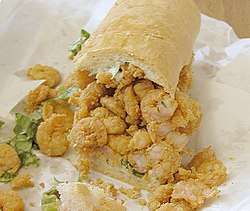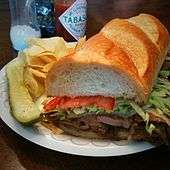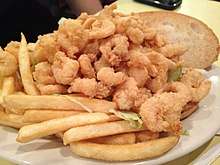Po' boy
A po' boy (also po-boy, po boy) is a traditional sandwich from Louisiana. It almost always consists of meat, which is usually roast beef or fried seafood, often shrimp, crawfish, fish, oysters or crab. The meat is served on New Orleans French bread, known for its crisp crust and fluffy center.
 Shrimp po' boy | |
| Alternative names | po-boy po boy |
|---|---|
| Place of origin | New Orleans, Louisiana |
| Region or state | Louisiana, Southeast Texas, Alabama, Mississippi, Georgia, South Carolina, Southeast North Carolina and the Florida Panhandle |
| Main ingredients | Multiple |
| Variations | Multiple |
Preparation
Roast beef was New Orleans' most popular po'boy filler up to the 1970s,[1] but a wide selection of fillings are possible as long as the "po' boy bread" is used[2]), with fried shrimp,[3] fried crawfish,[3] fried catfish,[4] Louisiana hot sausage,[5] ham,[3] fried chicken, duck, and rabbit listed among possible ingredients.
A "dressed" po' boy has lettuce, tomato, pickles, and mayonnaise.[6] Fried seafood po' boys are often dressed by default with melted butter and sliced pickle rounds. A Louisiana style hot sauce is optional. Non-seafood po' boys will also often have Creole mustard.
Aside from meat and seafood, cheese has also been a recognized ingredient since the Great Depression,[8] the sandwich's inception occurring at the beginning of that period (year 1929).[7]
The fried oyster po'boys are also referred the distinct name "oyster loaf", and apparently has a different and older history.[9][10]
The New Orleans "sloppy roast beef" po' boy, thick cuts are served with gravy,[11][12] or for the "CrockPot tender" type the beef is stewed down until melded with its sauce,[12] while in a third style, thinner slices are dipped in beef jus.[12] Garlic is an optional seasoning.[12]
Origin of the term

In the late 1800s fried oyster sandwiches on French loaves were known in New Orleans as "oyster loaves", a term still in use. A sandwich containing both fried shrimp and fried oysters is often called a "peacemaker" or La Médiatrice.[10]
A popular local theory claims that the "poor boy" (later "po' boy", etc.) as specifically referring to a type of sandwich, was coined in a New Orleans restaurant owned by Benjamin ("Benny") and Clovis Martin, former streetcar conductors originally from Raceland, Louisiana. The Martins established their eatery in 1921, but it wasn't until 1929 that the bakery of John Gendusa first baked the bread to be used for this sandwich.[7][13] In 1929, during a four-month strike against the streetcar company, the Martin brothers served their former colleagues free sandwiches.[13]
The Martins had been interviewed on record regarding the origins of the sandwich. Benny Martin reminisced that they at the restaurant would jokingly referred to an incoming diner as "another poor boy" if he turned out to be one of the strikers.[13] The Martin brothers were also posed the question of whether the name was inspired by some French or French patois word such as pourbois, but they denied that was the case.[7]
One New Orleans historian finds the Martin claim suspicious for several reasons, starting with the fact that it wasn't described by the local press until 40 years after the strike, and that prior to 1969 the story from the Martin brothers themselves was that they had created the po-boy for farmers, dock workers and other "poor boys" who frequented their original location near the French Market. (The Martin brothers did write a letter, reprinted in local newspapers in 1929, promising to feed the streetcar workers, but it referenced "our meal" and made no mention of sandwiches.)[14]
New Orleans

New Orleans is known for its grand restaurants (see Louisiana Creole cuisine), but more humble fare like the po' boy is very popular.[15] Po' boys may be made at home, sold pre-packaged in convenience stores, available at deli counters and most neighborhood restaurants.[15] One of the most basic New Orleans restaurants is the po' boy shop, and these shops often offer seafood platters, red beans and rice, jambalaya, and other basic Creole dishes.[15]
The two primary sources of po'boy bread are the Leidenheimer Baking Company and Alois J. Binder.[16] There is fierce competition between po' boy shops, and resident opinions of the best po' boy shop varies widely.[17]
Each year there is a festival in New Orleans dedicated to the po' boy, the Oak Street Po'Boy Festival.[18] It is a one-day festival that features live music, arts, and food vendors with multiple types of po' boys. It is held in mid-November along a commercial strip of Oak Street in the city's Carrollton neighborhood.[18] The festival gives "best-of" awards, which gives the chefs an incentive to invent some of the most creative po' boys.[17]
Variations
Authentic versions of Louisiana-style po' boys can be found along the Gulf Coast, from Houston through the Florida Panhandle. The term "po' boy" has spread further and can be found in the South Atlantic States and in California, where it may instead refer to local variations on the submarine sandwich.
Houston has its own variety of the Po-Boy,[19] with chowchow added to ham, salami and provolone cheese.[20].[19] The sandwich is currently known as the "Original Po' Boy" and was previously the "regular". There is also a version with added meats and cheeses called the "Super".[21] Stephen Paulsen of the Houston Chronicle stated that the "Original" variety is "in the city’s food DNA, the Shipley Do-Nuts of sandwiches."[22] It was developed by Lebanese American Jalal Antone,[22] owner of Antone's Import Company in the Fourth Ward, in 1962 after his brother-in-law stated that area residents at the time would not be accustomed to Levantine cuisine, and therefore the business needed to focus more narrowly on locally-familiar cuisine. John Lomax of Houstonia described the 1970s and 1980s as the height of their popularity and that the growth of chain sandwich shops that operated across the United States, the introduction of banh mi, and the poor quality of third party sandwiches in gas stations resulted in a decrease in popularity for the variety. Lomax in particular stated that the storage of the sandwiches at grocery stores ruined the flavor due to the delicate properties of the chowchow and mayonnaise.[19] In 2002, 40% of the sandwiches sold at Antone's were the "Original" variety.[20]
Today traditional po' boy shops offer gumbos, bisques, jambalaya, crawfish kickers and boudin, a Cajun sausage.
See also
- List of American sandwiches
- List of sandwiches
- Louisiana Creole cuisine
- Muffuletta
References
- Citations
- Roahen (2008), p. 104 citing The New Orleans Underground Gourmet.
- Roahen (2008), p. 113.
- Roahen (2008), p. 111.
- Roahen (2008), pp. 109, 112.
- Roahen (2008), p. 112.
- Roahen (2008), p. 100.
- Cohen, Hennig (February 1950). "The History of 'Poor Boy,' the New Orleans Bargain Sandwich". American Speech. Duke University Press. 25 (1): 67–69. JSTOR 454218.
- The Federal Writers Project, The New Orleans City Guide cited by Cohen.[7]
- Roahen (2008), p. 106.
- Anderson, Brett (April 20, 2012). "Was the oyster loaf invented in (gasp!) San Francisco?". New Orleans Times-Picayune. Archived from the original on September 4, 2012. Retrieved 2013-06-15.
- Widmer, Mary Lou (1989). New Orleans in the Thirties (2 ed.). Pelican Publishing Company. p. 49. ISBN 0882897365.
- Roahen (2008), p. 114.
- Edge, John T. (November 11, 2009). "Saving New Orleans Culture, One Sandwich at a Time". The New York Times. Archived from the original on December 24, 2016.
- Karst, James (February 5, 2017). "If po-boys were invented in 1929, how was Louis Armstrong eating them a decade earlier?". The Times-Picayune. New Orleans. Archived from the original on February 6, 2017. Retrieved February 6, 2017.
- Rhinehart, Ed. "New Orleans Po'Boy Shop". Retrieved 8 May 2012.
- Roahen (2008), p. 115.
- Garbarino, Steve. "The Crescent City's Greatest Po'boys". ProQuest 855034442. Cite journal requires
|journal=(help) - "Oak Street Po'Boy Festival". Retrieved 8 May 2012.
- Lomax, John (2013-06-18). "The Rise And Fall Of The Houston Po' Boy". Houstonia. Retrieved 2019-11-19.
- Huynh, Dai (2002-10-04). "Digest: Antone's adds sauce to recipe for success". Houston Chronicle. Retrieved 2019-11-22.
- Cook, Allison (2017-09-11). "Antone's Original Po' Boy, a taste of my Houston history". Houston Chronicle. Retrieved 2019-11-22.
- Paulsen, Stephen (2018-10-08). "The strange saga of the Antone's po' boy". Houston Chronicle. Retrieved 2019-11-22.
- Bibliography
- Roahen, Sara (2008). Gumbo Tales. New York: W. W. Norton. p. 104.CS1 maint: ref=harv (link)
External links
| Wikimedia Commons has media related to Po' boys. |

